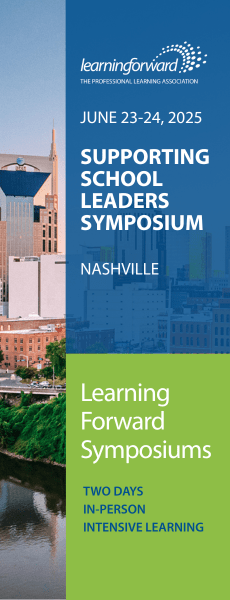A state for excellence
New Jersey boosts learning power with online video resources
By Learning Forward
October 2011
Vol. 32 No. 5
Read the remaining content with membership access. Join or log in below to continue.
Sed ut perspiciatis unde omnis iste natus error sit voluptatem accusantium doloremque laudantium, totam rem aperiam, eaque ipsa quae ab illo inventore veritatis et quasi architecto beatae vitae dicta sunt explicabo. Nemo enim ipsam voluptatem quia voluptas sit aspernatur aut odit aut fugit, sed quia consequuntur magni dolores eos qui ratione voluptatem sequi nesciunt. Neque porro quisquam est, qui dolorem ipsum quia dolor sit amet, consectetur, adipisci velit, sed quia non numquam eius modi tempora incidunt ut labore et dolore magnam aliquam quaerat voluptatem.
A structure for professional learning
New Jersey’s regulations on professional development for teachers provide a foundation for effective professional development planning and review at the county, district, and school level through the use of the New Jersey Professional Development Standards and a governance structure that promotes collaborative planning for professional development with teachers, administrators, and other key stakeholders. This structure includes:
Professional Teaching Standards Board: A state-level, 19-member advisory committee of 10 teachers and other education stakeholders that advises the commissioner on policies and resources for the professional development for teachers requirement.
County professional development committee: A 15-member board of seven teachers and other education stakeholders that reviews, provides feedback, and approves district professional development plans.
Local professional development committee: A six-member committee of four teachers and two administrators that guides the district-level professional development planning process. The district uses district-level data and school goals to support effective professional development in and across schools, focusing on districtwide priorities.
School professional development committee: A four-member committee in each school of three teachers and the principal that guides the school’s professional development planning process. The school uses school-level data to identify key professional development needs.
Success at the Core materials are available free of charge to anyone who registers at www.successatthecore.com.
Learning designs using video
Video of classroom instruction is a powerful medium for offering images of effective practice. But watching video, by itself, does not change practice. To be most effective, viewers must deepen their understanding of what they view and take away lessons that can improve practice. Here are design features to consider when crafting professional learning that incorporates video:
Pose reflective questions that support individual and group learning.
Before viewing:
- What are the norms to employ in viewing? (Think about norms used for classroom visitations.)
- What do you want to learn about?
- What school/district priorities and specific student needs motivate the viewing?
After viewing:
- What did you observe, as it relates to the goals and motivations you brought to the experience?
- What did you observe about teacher interactions with the students? Student interactions with other students?
- How is the room organized to support learning?
Provide materials that supplement the video.
- What artifacts of the observed work can support and supplement the learning from the video?
- What samples of student work from the filmed classroom, curriculum materials, and lesson plans can give a more textured understanding of the practice being observed?
- What activities help team members juxtapose what they saw in the video with their own reality?
Support group discussion and next steps.
- What key ideas do you take away individually and as a group from this video?
- How does the reality of the video contrast with the personal reality of the viewer and the reality of the school?
- So what? Then what?
Design features that support job-embedded professional learning
By design, school-based educators guide their teams through Success at the Core’s leadership development modules. Several online tools exist to support and build internal capacity.
24/7 availability: Because they are online, materials are available whenever teams have time. An Internet connection, projector, a printer for handouts, and a computer come together to support team learning.
Easily customized materials: The variety of research-based topics allows leaders to choose the materials that attend to local priorities and immediate professional learning needs as they arise. While modules last two to three hours, self-contained segments — with their specific goals, videos, readings, team self-assessments, and reflective materials — can be taken up to fit a team’s available time.
Downloadable resources that build school-based facilitator capacity: An overview helps facilitators consider the big picture: engaging colleagues in professional learning, eliciting the leaders’ support, mapping out use of the materials in advance, and ensuring the desired outcomes take hold within the community.
Each module includes a detailed facilitator guide, agenda, and supporting handouts. The facilitator guide names what preparation can be done in advance, lays out how long each activity will take, predicts what issues may reveal themselves as the work ensues, and offers effective discussion and reflection protocols.
Multimedia presentation: To further assist the facilitator, a module’s learning experience is laid out in a multimedia presentation — an online, PowerPoint-style presentation that includes the module’s learning goals, handouts, discussion questions, and video in the order in which they are needed in the module. This projection becomes an organizer of the resources, as it lays out their relevance across the learning experience, and acts as a “co-facilitator,” supporting teams to stay focused and on track.
References
Killion, J. & Roy P. (2009). Becoming a learning school. Oxford, OH: NSDC
Learning Forward is the only professional association devoted exclusively to those who work in educator professional development. We help our members plan, implement, and measure high-quality professional learning so they can achieve success with their systems, schools, and students.
Recent Issues
LEARNING DESIGNS
February 2025
How we learn influences what we learn. This issue shares essential...
BUILDING BRIDGES
December 2024
Students benefit when educators bridge the continuum of professional...
CURRICULUM-BASED PROFESSIONAL LEARNING
October 2024
High-quality curriculum requires skilled educators to put it into...
LEARNING TO PIVOT
August 2024
Sometimes new information and situations call for major change. This issue...










